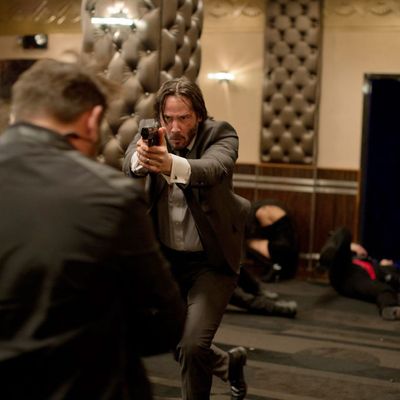
With any other actor in the role, the relentless revenge flick John Wick could have been just another variation on the Neesonian man-with-special-set-of-skills-kills-everybody genre. But with an actor as ethereal and ageless as Keanu Reeves in the lead, it becomes something else — more abstract and mythic.
At this point, Reeves can do stoic and haunted in his sleep. As John Wick begins, he’s (stoically, hauntedly) mourning the recent loss of his wife to a terrible illness. But then a little dog is delivered to his door one day — accompanied by a card bearing the same yellow-daisy design as his late wife’s coffee mug. It turns out she bought the puppy for him to help him grieve after her death. She was right: Having the pitter-patter of an adorable mutt following him around and jumping into his cold, empty bed with him does seem to brighten Wick’s day — marginally. (He’s still pretty stoic and haunted.) Thing is, the guy has nothing else to do. He lives in this giant, sleek, ultramodern house and drives a beautiful black ‘69 Ford Mustang. Most of his time seems to be spent taking care of his dog or angrily doing 360s and gunning his car around a nearby private airfield. That’s how stoic, haunted badasses mourn in the movies.
Then, a group of young, stuck-up Russian thugs led by mob princeling Iosef (Alfie Allen) invade Wick’s home, beat him to within an inch of his life, steal his car … and kill his dog. When Wick wakes up, he finds his dog’s carcass nestled next to him, a trail of blood-soaked doggie footsteps on the floor — with its dying breaths, the poor little creature apparently dragged itself over to die alongside his owner. And people, I am telling you … I don’t know if I’ve ever wanted somebody in a movie dead as much as I wanted those punks dead at this point in John Wick. This is shameless cinematic manipulation of the first order, but the film knows to parcel it out in doses. In The Equalizer, the manipulation never stopped; once Denzel Washington’s character got going, the villains’ brutality increased exponentially. John Wick is cleaner: It gives us a visceral reason for the bloodshed, but then it plays it cool. Its ambitions are aesthetic, not moral.
Up until this point, the film has played coy about who John Wick actually is, but now the truth is revealed, in a slow, anticipatory, Chinese-water-torture drip of exposition. Derek Kolstadt’s screenplay understands that so much of a character’s magnetism depends on what happens when he isn’t around, so the film has as much fun dancing around the details of Wick’s former life as it does in showing us just how exactly he goes about his business. But it turns out that before meeting his wife and retiring, Wick was a legendary hit man known as the Boogeyman. “John wasn’t exactly the boogeyman. He was the one you sent to kill the boogeyman,” elaborates his former employer, Russian mobster Viggo Tarasov (Michael Nyqvist), who just so happens to be the father of the same hotheaded ignoramus who killed Wick’s dog. Now the entire underworld is scrambling to prepare for the ultimate killer’s return, and the inevitable bloodletting that will ensue. The hushed, terrified tones with which the mobsters discuss Wick ahead of his arrival help prime us for the film’s action scenes.
And those action scenes are something else, too. Directors David Leitch and Chad Stahelski are veteran stunt coordinators, so the fighting, the shooting, the neck-snapping and back-breaking and head-exploding are shot with startling fluidity. But they also appear to have taken a few pages from the heyday of arty action like La Femme Nikita and The Professional, films that were built not on anything real, but on our collective cinematic dreams of genre. When Wick chases one Russian in the middle of a rave, what’s onscreen becomes as much about the spiraling patterns on the club’s video screens and the gyrating dancers as it does about the actual pursuit at hand. The fight scenes themselves develop their own dancelike rhythm and grace.
None of this is new: Filmmakers have been aestheticizing violence for as long as movies have been around, and the idea of yet another action flick with hot music and cool images (however hot the music, however cool the images) may not strike many as cause for celebration. But John Wick commits to its defiant unreality, giving us a fantastical underworld of ritual, mythic figures and color-coded spaces. When Wick kills a bunch of goons in his home, he calls a professional mob-body-cleanup service led by a guy who looks like the Reaper himself. He pays for everything in gold coins that appear to be the currency of this realm. There’s even a common hotel that all the hit men stay at, with its own rules (no business conducted on the premises, or you pay a hefty fee) and its own secret spaces, such as a basement bar where owner Ian McShane holds court and dispenses wisdom over a martini. Such genre fantasies give the directors plenty of cover. John Wick is a violent, violent, violent film, but its artful splatter is miles away from the brutality of Taken or the gleeful gore of The Equalizer. It’s a beautiful coffee-table action movie.





